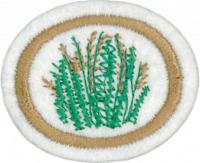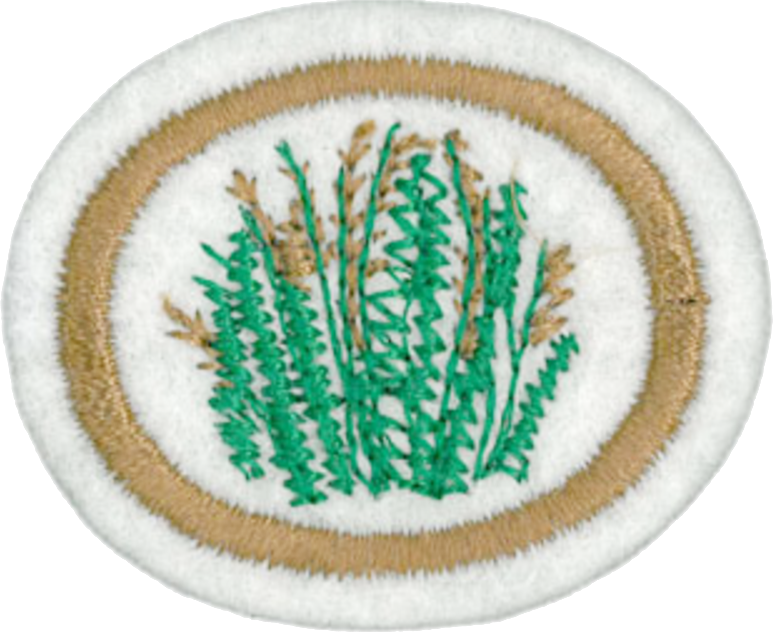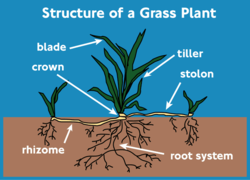1
Grasses generally have the following characteristics:
Poaceae have hollow stems called culms, plugged at intervals called nodes. Leaves are alternate, distichous (in one plane) or rarely spiral, parallel-veined and arise at the nodes. Each leaf is differentiated into a lower sheath hugging the stem for a distance and a blade with margin usually entire (meaning continuous and un-toothed). The leaf blades of many grasses are hardened with silica phytoliths, which helps discourage grazing animals. In some grasses (such as sword grass) this makes the grass blades sharp enough to cut human skin. A membranous appendage or fringe of hairs, called the ligule, lies at the junction between sheath and blade, preventing water or insects from penetrating into the sheath.
2
Grasses (and several other plants) have roots called rhizomes. A rhizome is a horizontal stem of a plant that is usually found underground and often sends out roots and shoots from its nodes. Rhizomes may also be referred to as creeping rootstalks, or rootstocks. Rhizomes typically have short internodes; they send out roots from the bottom of the nodes and new vertically growing shoots from the top of the nodes.
For many plants, the rhizome acts as the "seed", and is used by humans to propagate the plants.
3
The Poaceae is also known as the Gramineae. There are about 600 genera and between 9,000 to 10,000 species of these plants. Plant communities dominated by Poaceae are called grasslands; it is estimated that grasslands comprise 20% of the vegetation cover of the earth. This family is the most important of all plant families to human economies: it includes the staple food grains grown around the world, lawn and forage grasses, and bamboo, widely used for construction throughout Asia.
4
All grasses are monocotyledons, so the seeds have only one part.
5
Grass blades grow at the base of the blade and not from growing tips. This location of the grass growing point near the ground allows it to be grazed or mowed regularly without damage to the growing point.
6
- Barnyard grass (Echinochloa crus-galli)
- Crabgrass (Digitaria spp.)
- Common wild oat (Avena fatua)
- Foxtail grass (Alopecurus spp.)
7
- Couch Grass (Elytrigia repens)
- Panicum (Panicum spp.)
- Fescue (Festuca spp.)
- Kentucky bluegrass (Poa pratensis)
8
8a
Wheat, Rye, Barley, Oats, Corn
8b
Broomsedge
8c
Bamboo
8d
Wheat, Rye, Barley
8e
Wheat, Rye, Corn
8f
Rye, Timothy, Brome, Fescue, Coastal Bermuda, Orchard grass
8g
Maize (corn)
8h
Sugarcane, Sorghum
8i
Oats
8j
Corn, Rice, Wheat
8k
Sugarcane, Corn
8l
Wheat
9
Review requirement 11 before starting on this one. If you follow requirement 11 as outlined, requirement 9a will be fulfilled.
9a
Cultivated grasses include the cereal grains as well as lawn grasses:
- Grains
What, rye, oats, corn, sorghum, sugarcane, bamboo, etc.
- Lawn Grasses
Bahia grass, Bermuda, Buffalo, Fescue, Kentucky Bluegrass, St Augustine, Zoysia, etc.
9b
The most important use of grass in the world is as a food staple. Entire civilizations were founded on the ability to grow grain. Rice is used in Asia; wheat, rye, and oats in Europe and Africa, and corn in the Americas.
Grass is also used as the main plant on lawns, as feed for livestock, in broom making, thatching, and for fuels (including biodiesel). Corn husks are used for making dolls as well as for cooking vessels (i.e., wrap the food in corn husks and place it on a bed of coals).
Grass is also used for making clothing (hula skirts anyone?), mats, composting, mulching, bedding for humans and for livestock, and even as a primary building material in straw-bale construction.
It was used in rope-making by the Incas in South America, and these ropes would then be used to build bridges spanning large canyons.
10
"Pestiferous" means "weedy" in this case, and you should keep in mind, that a weed is any species growing where it is not wanted by humans. Fescue in the flower bed is a weed. Fescue in the lawn is not. Use your own judgement as to what is and what is not a weed.
Flower stalks should be pressed, and seed stalks should be dried. To press the flower stalks, place them between paper towels or some other absorbent material, then place between the pages of a heavy book. Close the book, and if desired, place the book at the bottom of a large stack of books. Another way to press them is to place the plants again between paper towels, then place that between two boards. Clamp the boards together. Whichever approach you use, leave the specimens there for several days.
For drying, all you need to do is leave the grass in a dry environment - on top of a bookshelf or in a closet. As long as it is dry, the seed stalks will dry just fine.
To mount the stalks, simply fasten them in place on a sheet of paper using transparent tape. This does not need to be nothing more than a spiral notebook, but if the Pathfinder wants to make it fancy, that should not be discouraged.
11
This requirement is referring to an old version of requirement 9, which read as follows:
- Because of their value as food for man and/or his domestic animals, about sixty species of grasses are cultivated in the United States. Make a collection of, and correctly label, the seeds of ten of these valuable species.
The main difference between this requirement and the current incarnation of requirement 9a, is that this requirement stipulates that the plants should be pressed or dried, and mounted, and that they be grown to your neighborhood. Therefore, if the plants collected in requirement 9a are collected from your neighborhood, and if they are pressed or dried and mounted, this requirement is already finished.



